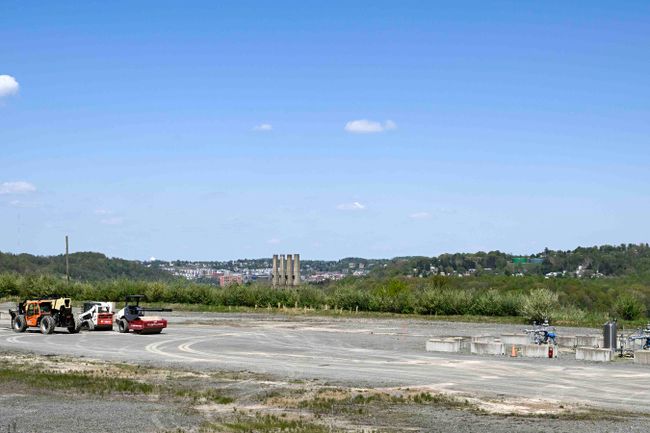 Drilling for the new WVU geothermal data-collection well is set to begin during the second week of May. The well is located at an existing well pad operated by Northeast Natural Energy in the Morgantown Industrial Park. Core samples at shallower depths will be collected to study the potential for underground carbon storage. (WVU Photo/Jennifer Shepard)
Drilling for the new WVU geothermal data-collection well is set to begin during the second week of May. The well is located at an existing well pad operated by Northeast Natural Energy in the Morgantown Industrial Park. Core samples at shallower depths will be collected to study the potential for underground carbon storage. (WVU Photo/Jennifer Shepard)
This will be the first-of-its-kind geothermal study in West Virginia and will collect core samples and temperature data down to a depth of 15,000 feet, critical to testing the potential of geothermal energy in the region. Data also will be gathered on the potential for underground carbon storage in the Appalachian basin — another scientific first in the state.
The project is a collaboration first spearheaded by the WVU Energy Institute with WVU faculty and experts at Northeast Natural Energy LLC and the U.S. Department of Energy, with support from the West Virginia Geological and Economic Survey and Hewitt Energy Strategies.
The DOE provided approximately $9.1 million in funding from the Geothermal Technologies
Office and the Office of Fossil Energy and Carbon Management. Northeast Natural
Energy, WVGES and WVU contributed $2.76 million in cost-share funding.
Shikha Sharma, professor, geology, WVU Eberly Colleges of Arts and Sciences (WVU
Photo)
“The successful partnership between DOE, industry and academia to test the potential of both geothermal and carbon sequestration in the state is a significant step towards creating new economic opportunities in clean energy diversification,” said Shikha Sharma, geology professor in the WVU Eberly College of Arts and Sciences and the project’s principal investigator.
Drilling will be located at an existing well pad at the Morgantown Industrial Park
operated by Northeast Natural Energy, a West Virginia-based energy company.
B.J. Carney, vice president of Geoscience and Innovation, Northeast Natural Energy (Submitted Photo)

“It’s exciting for Northeast Natural Energy to be able to use its scientific and operational expertise to help better understand the geothermal energy and carbon capture potential of our great state,” said B.J. Carney, vice president of Geoscience and Innovation at Northeast Natural Energy.
This is the second drilling research project that Northeast Natural Energy has partnered on with WVU. The first was the Marcellus Shale Energy and Environment Laboratory for which WVU coordinated with academia, government and industry partners that started in 2015. MSEEL scientists used multiple Northeast Natural Energy wells near Morgantown to research new technologies to improve well production and minimize environmental impacts during unconventional natural gas development projects.
“We look forward to partnering with the researchers at WVU and the DOE to lead the way in the Appalachian Basin toward establishing additional clean energy sources,” Carney said.
“We are also eager to understand the feasibility of capturing and storing CO2 in
the subsurface to ensure a sustainable future for our vast natural gas resources
already in place. These types of projects fit with Northeast Natural Energy’s
focus on providing energy of all types to serve our communities and improve their
quality of life,” Carney added.

Sam Taylor, assistant director of Strategic Partnerships and Technology, WVU Energy Institute (WVU Photo)
“To be clear, instead of producing energy, this well will produce data,” said Sam Taylor, assistant director of Strategic Partnerships and Technology at the WVU Energy Institute. “The goal is to gather enough data to decide if geothermal reservoirs in the region can be a cleaner energy source for parts of West Virginia and mid-Appalachia, along with collecting data on possible carbon storage.”
“We’re excited that the test well will provide WVU students with hands-on experience
in the field, working with industry professionals while collecting data, providing
them with invaluable, real-world experience as a part of their academic studies
at WVU,” Sharma said.

James Wood, director, WVU Energy Institute (WVU Photo)
“This is the sort of community and University engagement and collaboration the WVU Energy Institute promotes,” added James Wood, Energy Institute director.
Another notable first of this research is that no entity had ever requested a deep
geothermal science well drilling permit in West Virginia. Northeast Natural Energy
worked closely with the West Virginia Department of Environmental Protection,
Office of Oil and Gas, to make sure all appropriate permits were in place.

Brett Loflin, vice president of Regulatory Affairs, Northeast Natural Energy (Submitted Photo)
“We are very grateful for the outstanding cooperation of the Office of Oil and Gas in moving this project forward,” said Brett Loflin, vice president of Regulatory Affairs for Northeast Natural Energy. “We are very fortunate to have a regulatory agency willing to work with us on what we believe will be an important scientific endeavor.”
House Bill 4098 was passed in 2022 and gave the Department of Environmental Protection regulatory oversight on geothermal energy. Taylor was invited to provide expert testimony to state delegates when the bill was reviewed.
“This project is a significant milestone in the testing of geothermal energy potential, not only in the state, but also in 70% of the U.S., where lower subsurface temperatures have prevented its use,” Sharma said.
-WVU-
tn-ts/04/28/23
MEDIA CONTACTS:
Tracy Novak
Communications Director
WVU Energy Institute
304-212-1496;
tracy.novak@mail.wvu.edu
Trip Showen
Northeast Natural Energy
304-767-0874;
tshowen@nne-llc.com
Call 1-855-WVU-NEWS for the latest West Virginia University news and information from WVUToday.
Follow @WVUToday on Twitter.